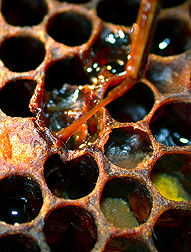Helping Beekeepers Beat American Foulbrood
|
|
American foulbrood (AFB)—caused by the spore-forming bacterium Paenibacillus larvae—is the most serious infectious disease of honey bees. Infected bee colonies must be burned, and that is costly for beekeepers.
Since the 1950s, the only treatment approved for use in the United States to prevent AFB has been the antibiotic oxytetracycline (OTC), sold under the brand name “Terramycin.” But there have been several reports over the past few years of loss of effectiveness of OTC.
Dan Murray, a molecular biologist in the ARS Honey Bee Research Unit at Weslaco, Texas, has figured out why, after so many years, the AFB bacterium has suddenly developed resistance to OTC. Murray, assisted by ARS molecular biologist Katherine Aronstein, discovered in P. larvae a natural plasmid—dubbed “pMA67”—that contains an OTC resistance gene. Plasmids are small DNA molecules containing up to several dozen genes that bacteria pass on when they reproduce.
This is the first report of any tetracycline resistance gene being found in any Paenibacillus bacteria.
Among 35 P. larvae strains tested from across the United States and 1 from Canada, all 21 OTC-resistant strains possessed this plasmid and all 15 OTC-sensitive strains did not.
“This finding was unexpected,” says Murray. “Other scientists have found plasmids in various AFB bacterial strains, but none of them conferred antibiotic resistance. This plasmid is significant because it has rendered useless what until very recently has been the only effective preventive treatment for AFB.”
Fortunately, ARS scientists at Beltsville, Maryland, have recently shepherded approval by the Food and Drug Administration of a new antibiotic against AFB called “tylosin.”
There are two likely reasons for the relatively rapid spread of OTC resistance: First, bees from broad geographical areas are brought together when beekeepers rent out their hives to agricultural producers for pollination. That means the bees can spread OTC-resistant bacteria to bees they wouldn’t normally encounter. Second, based on its DNA sequence, plasmid pMA67 is thought to have the ability to transfer to other bacterial cells in a process called “plasmid mobilization.” This means that, in addition to passing the plasmid—and its OTC resistance genes—on to their descendants, bacteria can physically transfer a copy of the plasmid to other bacterial cells they come in contact with. It is the same phenomenon largely responsible for spread of antibiotic resistance among disease-causing bacteria in humans. OTC resistance in P. larvae presumably began when, at some point, pMA67 was transferred from some other bacterial species into P. larvae.
“This is strong evidence for a mechanism behind OTC resistance in an important honey bee pest,” says Jay D. Evans, an ARS researcher at the Bee Research Laboratory in Beltsville, Maryland. “OTC resistance has arisen in many treated populations, and it will be interesting to explore the role played by this plasmid—and possibly others—in generating resistance.”
Antibiotic-resistant strains can be detected in the laboratory with standard microbiological procedures and assays. This discovery resulted in a DNA-based method of detecting antibiotic-resistant P. larvae and may also lead to better strategies for combating other infectious agents of honey bees.—By Alfredo Flores, Agricultural Research Service Information Staff.
This research is part of Crop Production, an ARS national program (#305) described on the World Wide Web at www.nps.ars.usda.gov.
K. Daniel Murray is in the USDA-ARS Honey Bee Research Unit, 2413 E. Hwy. 83, Weslaco, TX 78596; phone (956) 969-5012, fax (956) 969-5033.
"Helping Beekeepers Beat American Foulbrood" was published in the July 2007 issue of Agricultural Research magazine.







